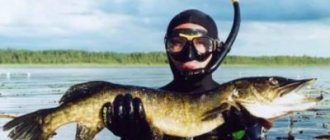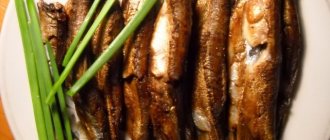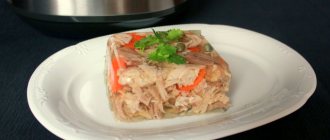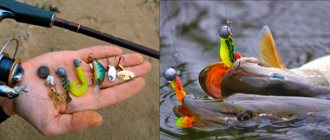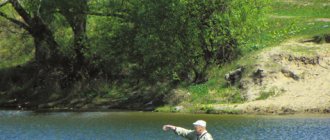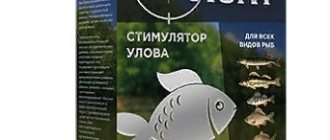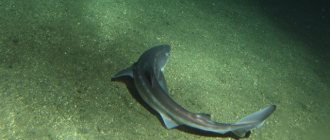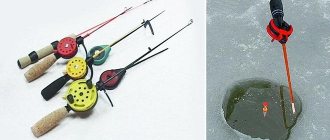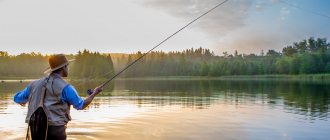A bouillon cube from Maggi, Knorr, Galina Blanca and others is an excellent and cheap attractant from the nearest supermarket or rural store, which is often available not far from the fishing spot.
An added bonus is that you can make delicious soup with it. How it is useful when used in fish bait and what fish it can be used on, we will consider below.
The bouillon cube has a strong spicy and salty taste due to the many spices, salt and monosodium glutamate it contains, and these components are included in many bait additives and various appetite enhancers.
Let's look at what is included in a bouillon cube:
We see the main components:
- Salt and flavor enhancers;
- Corn starch;
- Oils, fats and spices;
- Flavors.
As you can see, there is nothing wrong with it, and these components are regularly used by many fishermen.
Who to catch:
Such large roach is caught.
From my personal experience, this additive works well when catching roach both in winter and summer, and in the off-season.
Roaches love strong aromas, especially in winter.
The cubes work when catching whitefish and bream.
In my opinion and experience, this flavor works best in the winter season, and in the off-season when it is still cold - the beginning of spring and the end of autumn.
Cubes from any manufacturer are suitable as an attractant; expensive and cheap brands work equally well.
Varieties
Attractants to enhance the carp bite are divided into groups depending on the fishing location, the presence of a current, and the type of bait. They are produced in the following forms:
Powders. Does not contain aromatic oils, but only natural ingredients in certain doses. Packaged in bags of different weights. It is used both in current and in still water. Added to the main bait. Main components:
- maggot;
- bloodworm;
- mayfly butterfly larvae;
- a red or green worm is special;
- mud, river grasses;
- hemp, rapeseed, flaxseed cake;
- bran.
- Concentrated drops. Available in capsules of 3-5 ml, designed for single use. They are dosed in different ways, but, as a rule, the contents of the ampoule are diluted in 500 ml of water from a reservoir and poured into dry bait.
Liquids in the form of syrup. Has a lower concentration than drops. It is a viscous composition in bottles of different sizes. It comes in all sorts of colors and scents. The main components are betaine and concentrated amino acids.This attractant can be added to the bait or coated with it before casting.
- Pills. Available in packs of 500 and 1 thousand pieces. They are easy to use: throw 8-10 pieces into the fishing spot.
Once they reach the bottom, they begin to dissolve, forming a cloud that spreads over a wide area and lures the victim. The disadvantage is that the effect of one portion is designed for one hour, then you need to repeat the cast again.
They have the widest range of aromas: vanilla, cinnamon, dill, anise, tutti-frutti, barberry and others.
Among the taste preferences of carp, it is worth noting: honey, caramel, hemp, garlic, fruit aromas.
Carp baits can be divided into two types:
Sweet compounds. They are recommended to be mixed with activators based on essential oils and fruit or sweet products: halva, cookies, etc.
- Spicy compounds. They need to be enhanced with the smell of dill, sunflower, and cake. In the cold season, aromas of animal origin are effective: shells, cod liver, crab attractants. You can use fishmeal, canned food, and boiled shrimp. Use them separately or complement them with the smell of garlic or hemp.
In spring and summer, fish prefer fruity and sweet aromas. During the cold period - smells of animal origin - canned fish, fish oil, blood, poultry offal and spices.
Why does a bouillon cube work?
The attractiveness of this attractant is associated with the presence of a large amount of salt in it, you can read about the benefits of salt for fishing in this article, and the presence of aromatic spices, this all enhances the taste of the bait many times over, and stimulates the fish to eat it better and stay on the bait longer place.
In winter, the presence of salt in the bait is mandatory, the fish lack this mineral, in the summer they can probably make up for it due to the presence of insects and other animal food. The need for nutrients is present in bream, roach and other white fish.
We recommend: Lake Pavlenskoye
The aroma of the cube is similar to the smell of grass and mud where fish like to congregate.
Fishing sauces
Dips are a type of attractant. The name comes from the English word “dip”, which means dipping, immersion. They are impregnating liquids containing amino acids, sugar, and flavorings. They come in liquid, powder, and gel forms. The bait is dipped into them before casting, after which it is saturated with aroma and other properties attractive to fish.
These supplements are now produced by hundreds of manufacturers. Despite all the diversity, they are divided into two groups:
- Simple - capable of luring fish. They were originally used for catching bream, crucian carp, and other types of fish. They are oil-based liquids mixed with aromatic substances. They are simple and convenient, good for short fishing, and nowadays they are successfully used by fishermen. The bait is dipped into the odorous solution for a few seconds and is ready to be cast.
Simple ones include sticky dips. They are a sticky aromatic gel. The bait immersed in it is covered with a shell, which dissolves in water and attracts fish. Before use, place the jar in hot water. When heated, its contents become more liquid. The bait is dipped into it, then it cools in the air, turning into a gel again. Corn grains, pellets, and other bait particles can easily be glued to a still warm boilie treated with such an attractant.
Nutrients - lure fish and stimulate their appetite. They differ from simple ones in their manufacturing recipe and method of application. The bait is immersed in them for a long time. They are more stable and effective: they better transmit food signals to prey, and have a longer and more complex effect on the fish.
Luminous dips are nutritious; their composition contains a gel that can glow in water. Its greenish glow is the main attraction for fish. This type of bite activator is divided into two types: for daytime fishing and night fishing. The latter has the function of charging from the light of a flashlight.
The fish sees the ultraviolet glow of the bait. Adding sparkles to the substance gives a good attractive effect.
Suitable materials for using illuminated lubricants are ribbed silicone and foam rubber.
Many carp anglers prefer powder additives. When using them, the bait is dipped into water, then into powder and back into water. During these manipulations, the boilie is covered with a layer of jelly, which, dissolving in water for several hours, transmits appetizing and luring signals to the fish.
This type of nutritional fluid has many beneficial properties. Some are used as preservatives: boilies soaked in them remain fresh for several weeks even in hot weather. Other dips keep pre-dried baits moist for up to several months. Fishermen carry them with them, using them for a long time if necessary. They are also used to increase the efficiency of artificial baits.
You can buy them at any fishing department or make them yourself. The basis is taken of several nutritious liquids, different in properties, to which one or more other components are added: flavors, essential oils, powder components.
How to use a bouillon cube in bait
Using the cube is easy, just add water.
On average, I add two cubes per kilogram of bait. The difficulty of using cubes is that they do not dissolve well in cold water, so I first dilute them in a glass of boiling water in river water and pour this broth into dry bait.
If you grind them into powder and add them to dry bait, and then mix them with water, it will also dissolve, but not very well. In general, this does not affect the bite.
It is important to use cubes in bait that do not have other odors, for example, for roach I use the following recipe:
1 kg of feed, to swell it I add hot water in which I dissolve the cube. Next, in order to dry the bait, I add either soil from molehills or regular breadcrumbs, and roll the balls, as in the photo below. Sometimes you can add corn or other fillers.
You can boil homemade boilies for bream or carp in the broth; sometimes they work well, but are not predictable.
In general, try it, if you try it, write a comment.
Subscribe to our channels on social networks: , , .
Types of attractants
There are three main types of attractants. Let's look at them in more detail:
- Liquid for impregnation (dip). The bait is immersed in liquid for 10 seconds.
- Sprayers. The use of sprays to spray bait is not very effective, since the applied substance does not saturate it well and is quickly washed off.
- Homemade attractants have proven themselves well, since in this case the fisherman can change the composition and select a special bait for each type of fish.
Powdered flavors
Dry attractants have gained recognition among the fishing community. They are added directly to the bait. This form of release has the following advantages:
- they are easy to use;
- adheres well to wobblers and worms;
- retain the smell for a long period;
- strong current is not an obstacle to the use of such substances;
- the formation of a tasty crust is due to rapid swelling;
- the presence of stabilizers allows such attractants to be stored for a long time;
- The content of substances in a concentrated form allows you to use the product economically.
By adding a dry attractant to dough or bait, you can expect a rapid activation of amino acids. However, the aroma should not be too strong. In this case, even a well-fed predatory fish will definitely react to the presence of these substances in the water.
Recommended reading: Fishing from ice
The powder should be mixed on the eve of the planned fishing. This will allow the active components to mix evenly with the fertilizer and permeate it with their scent.
"Predatory" attractants
While everyone has long been accustomed to all sorts of “stinkers” for “white” fish, attractants for catching predators are still a novelty for many anglers. In this article we will think about the advisability of using them and consider the most interesting and popular “predatory aromas”.
It goes without saying that the first fish attractants had a “white” orientation - with the addition of vanillin, drops of anise, hemp and other things to the bait, the long history of flavorings began. After carp fishing came into fashion, a new impetus appeared in the development of all kinds of “stinks” and “smells,” since it is no secret that the most powerful and at the same time, the most expensive and high-quality flavors are made specifically for carp fishermen. Over time, the “fragrant” trend reached spinners.
Let me give you an example from my fishing practice. Several years ago I was fishing in shallow water in the bay of the reservoir. I caught “zero” wobblers, for example, Duel&Yo-Zuri Shallow Crank, which was then called differently. That day, the pike came out for the bait, but did not show further activity, i.e., it is clear that it came out for the bait, but turned around and left. And a friend who was fishing in a neighboring boat had fish that were more active in taking the bait, i.e. There were attacks on the wobbler. As it turned out in the end, the secret to success was simple - ordinary fish oil! By and large, even now almost all attractants for predators are made on the basis of the most common fish oil . And further practice has shown that its use can help get the desired bite, especially when the fish is passive.
In fact, all “predatory” aromas can be divided into two types - thick and liquid . Liquids come in either a thicker, oily consistency or in the form of sprays.
The most famous “spray stinkers” are made by the American company Yum , they also produce special porous bullet weights for them - and they work really well in pairs. This combination is relevant when fishing in grass or snags. But its main disadvantage is that it is too liquid and is only suitable for some kind of impregnation. That is, unlike gel, it is almost pointless to “spray” them on the bait, since the aroma will hardly last and the bottle will have to be used too often.
But, for example, BerkleyValley already has a thicker structure, more similar to the appearance of sunflower oil. The aroma is quite interesting and working. As the name suggests, it is intended for pike perch. It works best in “cold” water – early spring, late autumn and winter.
Therefore, liquid attractants are more suitable for home use as impregnation for silicone or foam rubber baits. The principle is extremely simple. We take the most ordinary silicone, rinse it under water in order to wash off at least some of the oil from the silicone, then it will be better saturated and put it in the most ordinary zip bag or airtight jar. We fill it all with our attractant and within a day the silicone will partially absorb the smell. Important! Avoid putting dark and bright colored baits together, such as chartreuse, as the brighter colors will tint the darker shades. In addition, it is advisable to use silicone that is not equipped with it, since the same Berkley Valley simply “kills” the hooks.
Among the sprays, I would like to note Sensas Perch - unlike the previous ones, it has a compact size and easily fits in a pocket; in addition to the perch scent, there are ones intended for pike perch and pike. In general, it’s quite atypical, because this French company specializes in “white” fish, although, as it turned out, it even produces spinning rods. And this same perch spray is a completely working thing with a pungent meaty smell. You can simply “spray” it and this operation is enough for five to ten casts.
But, whatever one may say, gel predator attractants are much more practical and convenient to use. Firstly, they do not leak, and secondly, they provide a wider range of applications. And they can simply be applied to bait - from silicone to wobblers and spinners.
And the most famous and popular of them is Megastrike , which really made a lot of noise. Its packaging is similar to a tube of toothpaste and the line of scents is constantly expanding, but I can’t say that it is truly wide. You can squeeze it out of the tube a little and rub it over the bait a little - this will spread the smell more strongly. I can’t say that it really works miracles, but often the dynamics of the bite when using it increases. If possible, it is better to order it directly from the USA, since those made for Europe, although they cost significantly less, are, unfortunately, worse. And, by the way, pay attention to the expiration date; Megastrike has it listed at the bottom of the package. Chemistry is chemistry, but the “overdue” product still loses some of its properties.
Megastrike Brief Review
Of all the companies that produce attractants for predators , Pro-Cure has the widest range; their line is truly mind-boggling. They produce both gels and oil aromas that also glow in the dark. But due to the fact that there is no longer an official dealer in the CIS countries, as well as their assortment, unfortunately, it makes no sense to consider them in detail. And if you do come across them, I recommend trying them, they are really worthwhile.
A short review of Pro-Cure attractants
By the way, don’t forget about regular sprays for “white” fish. It’s also worth experimenting with them sometimes. For example, the most common anise-scented spray works quite well when catching perch.
Among other things, even if you fish with “edible” silicone, it’s worth trying to apply aroma, this can add to the effectiveness of your bait. Because applied on top it will act as a sauce.
So, experiment, dear fellow fishermen, and no tail, no scales!
Features of a good activator
Each angler uses his own bait. Some buy a bite activator in a store, paying quite a lot of money for it, others prefer to cook it with their own hands. However, there are some qualities that should characterize both factory-made and home-made mixtures. Firstly, it is important for the activator to be able to attract potential prey even from a sufficient distance. The larger the area of the reservoir that the active pheromone in the attractant mixture covers, the greater the chance of returning home with a good catch.
Another characteristic is versatility. After all, it’s convenient when you can use the same bite activator for crucian carp, perch, in general, for both peaceful and predatory fish. However, the effectiveness of the product should not be affected by such diverse applications.
